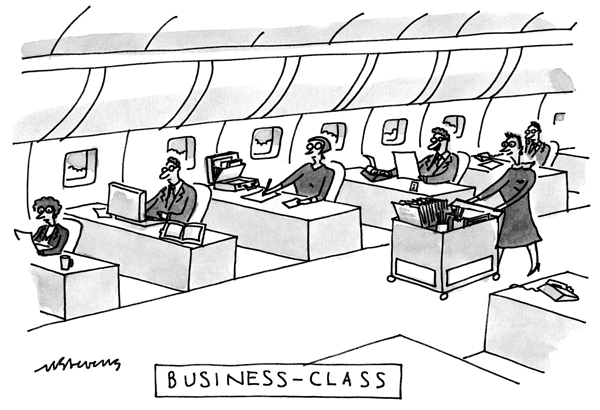| 
“I
am a Berliner!” Mayor Willy Brandt is pictured on June 26, 1963,
with German Chancellor Konrad Adenauer (r) and John F. Kennedy (l) in
an open car moving toward The Berlin Wall, where the U.S. President delivered
a speech to a crowd of some 300,000; it included a sentence that still
resonates in a much-changed world.
“Two thousand years ago, the proudest boast was ‘civis romanus
sum,’—I am a Roman citizen", Mr. Kennedy said.
“Today, in the world of freedom, the
proudest boast is ‘Ich bin ein Berliner!’
“All free men, wherever they may live,
are citizens of Berlin, and therefore, as a free man, I take pride in
the words ‘Ich bin ein Berliner!’” JFK declared. Those
words electrified the world (and no, he did not call himself a “jelly
donut”).
Last week marked 50 years since then, and
as the "freedom bell" tolled at the former West Berlin City
Hall, students from Berlin's John F. Kennedy School read speech excerpts
in German and English.
 illy
Brandt served as Chancellor of Germany from 1969 until 1974. illy
Brandt served as Chancellor of Germany from 1969 until 1974.
But Brandt came to political life and world fame as Mayor of Berlin from
1957 until 1966; at that time, the city was the foremost frontier of the
Cold War.
During the Willie Brandt era, the dreaded Berlin Wall was erected (1961)
and Checkpoint Charlie was as well known in many parts of the world as
Volkswagen.
But when it comes to airports, naming that
yet-opened colossal boondoggle Berlin Brandenburg Willy Brandt Airport
may be an omen and portent of things to come.
Now airport builders, politicians, city
fathers, and many other possibly well-intentioned people have branded
their dream airport after a man who refused to take some good advice;
apparently, they’ve followed his lead in that respect.
As July 2013 begins, despite opening the
gateway for a few air cargo flights, the handwriting may be on the wall
for the initial success or failure of BER. But if it’s like the
wall Berliners eagerly tore down upon reunification, then unfortunately,
no one got the message.
Brandt was born in 1913 in Luebeck, Germany,
as Herbert Karl Ernst Frahm.
“Willy Brandt” was a cover name
Brandt adopted in 1934 while living in Norway in the anti-Nazi underground.
Brandt’s politics and policies had always been controversial, and
he eventually was elected Chancellor of Germany, but was forced to step
down in May 1974 after reportedly ignoring early warnings from German
intelligence that one of his closest advisors, Guenter Guillaume, was
a Soviet agent.
Fast forward to 2013 as the prospect of
opening a new airport for Berlin (BER) draws closer (or maybe not), whilst
wondering how things have become so badly screwed up.
By examining a timeline of how a new airport
for Berlin has developed, we might better understand how things went wrong.
One thing is clear right away.
Many intelligence forecasts were made and
advanced by some pretty smart people at the early planning stages of BER,
even before the first shovel of dirt was turned.
Politicians and nearly everyone else ignored
these warnings, just like Willy Brandt ignored dire warnings of a spy
in his government.
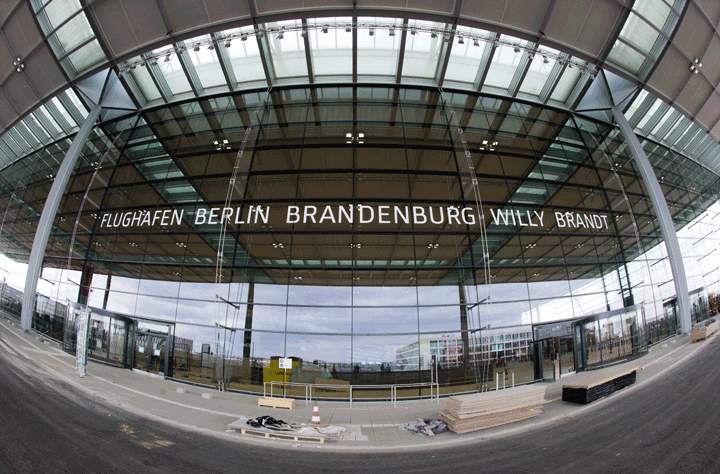
An exterior fish eye view of the main terminal at Berlin's Brandenburg
Willy Brandt at Schoenefeld, near Berlin, Germany, taken this past
March as news came out that BER was spending €4,600 a day on
electricity because they are unable to turn off the lights at the
facility.
|

Berlin’s first airport was Tempelhof,
an iconic place where history was made in the early days of aviation in
the 1920s; as we all know, it also kept the entire city of (West) Berlin
alive with cargo airlifts during the communist blockade in 1948-1949.
Although now closed, since 2008 THF continues
to be much loved and utilized as a center for Berlin City life with various
urban related activities.
Both the western part of Berlin and the
eastern part (which was also the capital of the former “German Democratic
Republic,” the Soviet satellite Germany) constructed new airports
post WW II—Tegel in the West and Schoenefeld in the East.
Immediately after German reunification,
plans started for a single Berlin Airport to replace Tempelhof, Tegel,
and Schoenefeld.
The regional planning process in 1993 favored
Sperenberg, a former Soviet military airbase within convenient distance
to Berlin, but with ample distance to residential areas. However, political
pressure led to a favorable decision for Schoeneberg, which in the initial
planning ranked only seventh, mainly because of the close proximity to
residential areas and the subsequent property costs associated with resettling
the residents.
Eventually, in May of 1996 the stakeholders
(the state of Brandenburg where Schoenefeld is located, the city of Berlin,
and the Federal Republic of Germany) agreed to build a new single airport
on the premises of Schoenefeld and close down both Tegel and Tempelhof.

In early 1997 the political stakeholders
decided to award construction and operation for the new single Airport
Berlin to a private operator.
The German construction giant Hochtief won
the related tender in 1999, only to have this award overturned by the
Berlin Superior Court shortly thereafter because of procedural errors
in the tender.
Another attempt to privatize the airport-to-be
was made in 2002 with Hochtief and IVG.
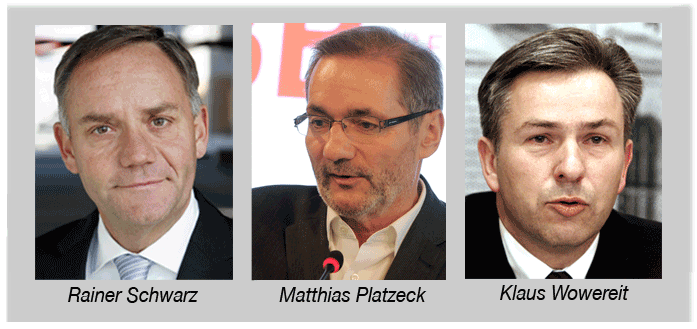 |
This time, Rainer Schwarz, the former Berlin
Airport CEO, Matthias Platzeck, Governor of Brandenburg State, and Berlin
Mayor Wowereit abandoned the project because financial foundations could
not be agreed upon.
Ultimately, in excess of €45 million
were paid to the Hochtief/IVG consortium to compensate for loss of the
contract.

Another round of tenders followed in which
the qualification criteria were much lower compared to the first one,
where only Hochtief qualified.
When multiple bidders eventually qualified
in the third round, illegal price agreements were suspected by the political
stakeholders and the concept of awarding construction and operation of
the new airport to a single contractor was eventually abandoned.

Instead, bids were called for single lots
of the airport’s construction, which were to be coordinated by the
stakeholders represented in the airport company—Brandenburg, Berlin,
and Germany.
Construction was underway in September 2006,
giving priority to infrastructure connections (railway and highway) and
the new runways; construction of the main terminal started in 2008.
At that time, plans called for an opening
of the new airport in late 2010, which later on was postponed to June
2012.
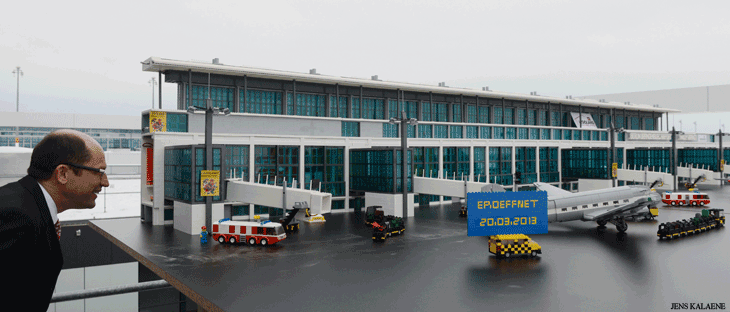
Too bad we didn’t build this airport in Legoland . . .
Head of the Berlin branch of German Air Traffic Control, Hans Niebergall,
views the miniature version of the BER (Berlin) airport built from
Lego bricks earlier this year. The model, which consists of about
100,000 Lego bricks and took six months to build, was presented
at a press conference
|

Soon, political stakeholders of all levels
started to meddle with the agreed-upon proposals and plans.
Retail space was deemed “insufficient”
after a study outlined lower-than-anticipated ancillary revenue; as a
result, the number of gates was cut back in favor of increased retail
space.
Also, the new airport was considered an
important icon for the capital of Germany, Berlin, so the floor was upgraded
from plain ceramics to 120,000 sqm of expensive Jurassic limestone to,
we suppose, simulate the experience of walking on air.
The plans eventually realized 15 aerobridges
and 20 boarding gates, enabling the new Berlin Airport to handle about
25-27 million passengers a year, later on expanded to 40 million passengers
a year.

However, the year 2011 saw the two operative
Berlin airports, Tegel and Schoenefeld, already handling in excess of
24 million passengers a year.
While original calculations estimated the
costs of the new Berlin Airport in the 1.7-2 billion Euro range, current
cost calculations figure it will cost about 5.4 billion Euros just to
get the already existing infrastructure functional.
The costs of expanding the airport to levels
where the anticipated 40-45 million passengers a year could be handled
are not (yet) included.

The opening of BER was postponed—this
time indefinitely—in June 2012 after the Brandenburg fire protection
authorities refused to sign off on core elements of the fire protection
equipment in the BER terminal building.
Sure enough German politicians, first in
line Mayor Wowereit, MP Platzeck and German Minister for Infrastructure
and Transport, Peter Ramsauer, showed highbrowed surprise and were quick
to demand “full investigations;” they also laid blame on airport
planners and contractors, in particular, star-architect Meinhard von Gerkan.

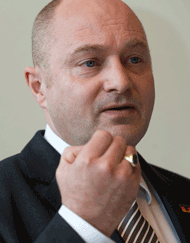 This
time, however, even the German public, which has a notoriously short-lived
memory for political issues, did not believe the statements. This
time, however, even the German public, which has a notoriously short-lived
memory for political issues, did not believe the statements.
After the supervisory board of BER (which
includes Chairman Mayor Wowereit, Vice-Chairman MP Platzeck and others,
including Rainer Bomba, (left) State Secretary of the German Transport,
Building, and Urban Development (representing Minister Ramsauer)) had
fired the airport manager responsible for the oversight of the technical
aspects and eventually Rainer Schwarz, the former Berlin airport CEO,
as scapegoats (stressing vociferously that none of the pertinent issues
had ever been duly communicated to the board members), they decided to
bring Horst Amman on board, who had a successful track record of overseeing
a number of large construction projects at FRAPORT, most notably the new
runway Northwest, which opened in 2011.

 As
FT reported earlier, attempts failed to bring in Wilhelm Bender,
(left) former successful CEO of Frankfurt Airport, as a replacement for
Schwarz after Berlin Mayor Wowereit and State of Brandenburg PM Platzeck
broke confidentiality in negotiations. However, today Herr Bender continues
to serve as a consultant to the project. As
FT reported earlier, attempts failed to bring in Wilhelm Bender,
(left) former successful CEO of Frankfurt Airport, as a replacement for
Schwarz after Berlin Mayor Wowereit and State of Brandenburg PM Platzeck
broke confidentiality in negotiations. However, today Herr Bender continues
to serve as a consultant to the project.
 In
a related development, the Vice President, State of Brandenburg PM Platzeck
replaced the President of the BER Supervisory Board, Mayor Wowereit, under
allegations that Wowereit had misinformed the public about the construction-related
problems. In
a related development, the Vice President, State of Brandenburg PM Platzeck
replaced the President of the BER Supervisory Board, Mayor Wowereit, under
allegations that Wowereit had misinformed the public about the construction-related
problems.
So now Wowereit has taken the seat of the
Board’s Vice President.
When German publications, notably DER
SPIEGEL reported that both managers Mr. Manfred Koertgen (right)
and Mr. Schwarz had communicated the issues which ultimately prohibited
the opening of BER, Board Members pointed out that “they lacked
the technical expertise to understand the full meaning of the briefings
received” and that the former airport management had not used language
plain and straightforward enough in such briefings.
Such statements must be called fascinating
at the least, coming from politicians charged with overseeing large infrastructure
projects who abandoned full privatization of the project because of a
promised, more cost-effective undertaking by the government itself.

Horst Amman, put in charge during all of
this for the technical aspects of BER Airport, went straight to work,
but sidestepped delivering cloudy promises and pointing fingers.
Amman instead undertook the task of making
an inventory about what went wrong and possible corrective measures.
 |
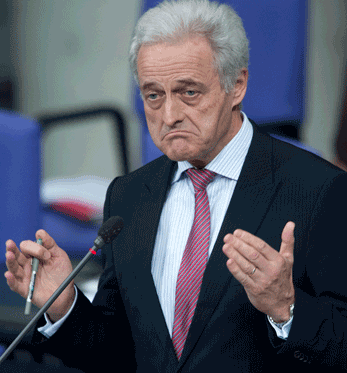 Obviously, the answers he had to give the supervisory board weren’t
much to their liking and seemingly contradicted the statements of the
now new CEO of BER, Hartmut Mehdorn, former CEO of cash-strapped Air Berlin
and notorious “sanitizer” of German rail monopolist Deutsche
Bahn.
Obviously, the answers he had to give the supervisory board weren’t
much to their liking and seemingly contradicted the statements of the
now new CEO of BER, Hartmut Mehdorn, former CEO of cash-strapped Air Berlin
and notorious “sanitizer” of German rail monopolist Deutsche
Bahn.
Mehdorn is a manager best called “controversial.”
His appointment here was thought in some
quarters to have been made for his political connections and not for his
successful track record.
One story has it that AB minority shareholder
Etihad Airways (whose financial contributions have helped keep AB afloat
since AB had to sell off and lease back most of their assets under Mr.
Mehdorn, including their aircraft, engines, and frequent flyer program)
demanded relief from Mr. Mehdorn in favor of Austrian Wolfgang Prock-Schauer,
a manager with proven air transport expertise.
But to the point of BER, the German public
radio station RBB reported that there was “notable dissent”
between Mr. Mehdorn and Mr. Amman, adding that “Mr. Mehdorn has
called for the sacking of Mr. Amman” because construction activity
in BER has come to a standstill while Mr. Amman makes his inventory and
investigates the shortcomings that led to the issues at hand.
While the supervisory board of BER, notably
Minister Ramsauer, (right) denied the RBB report and Mr. Amman himself
called the RBB report “incomprehensible, I do not see the tablecloth
between Mr. Mehdorn and myself cut,” it was felt that these denials
were aimed at downplaying the issue, but not contradicting that some form
of dissent exists between the fact-based technical manager Amman and the
political appointee Mehdorn.


Martin Delius (right) of the German Pirates
Party, head of the BER airport investigation committee in the BER Senate,
called recently for a clear commitment of the BER supervisory board to
Mr. Amman, saying that “Mehdorn’s plans for a partial opening
of the BER airport are not based in reality while Mr. Amman’s actions
and timetable are.
“If Mr. Mehdorn is the troublemaker
he will have to go,” Mr. Delius went on to say.
Various attempts by FT to get a
comment on this from the BER airport management went unanswered.

In a move not unheard of in politics, the
now former BER Chairman of the Board and Mayor Wowereit blamed the architect
of BER, Meinhard von Gerkan, for much of the issues relating to the indefinite
postponing of BER airport and the cost overruns associated with the construction.
Shortly before the latest attempt to open
BER, when the first media reports about pertinent issues started to sprout,
both Manfred Koertgen, then manager responsible for technical matters
at BER, and the supervisory board unanimously decided to fire von Gerkan
and drag him to court in order to claim €80 million in compensation
for the delays and cost overruns.
This, however, may not have been the smartest
move for political stakeholders with a standing track record of not-so-smart
moves; it seems obvious that whatever action an architect may have taken
and whatever plans he may have drafted, ultimately everything had to be
approved and put into action by the airport’s management and board.
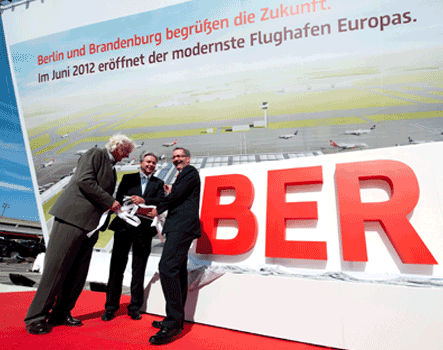 |
In happier times, German architect Meinhard von Gerkan (L)
with Berlin Mayor Klaus Wowereit (C) and Prime Minister of Brandenburg,
Matthias Platzeck, (R) as they unveiled a poster of BER, June 2011.
|

Von Gerkan, outraged at the accusations,
wrote a book called Black Box BER, which was supposed to be published
but was postponed after the new BER management put the lawsuit and the
associated liability proceedings on hold.
The publisher, Bastei Luebbe, comments
that publication is “on hold at least until late August this year”,
citing pending legal issues.
Von Gerkan, however, made the text available
to the German news magazine DER SPIEGEL, who promised “von
Gerkan hitting back and getting his revenge” by giving a “noteworthy
list of wrongdoings and wrong goings.”
DER SPIEGEL quotes von Gerkan
as saying “the artwork in BER seem(s) to be a fair indicator of
the ‘lack of reality’ barometer of airport managers and supervisory
board, in particular a flying carpet in the departure hall made from woven
aluminum strings, which underscores the (airport management’s) belief
in wonders and fairytales.”
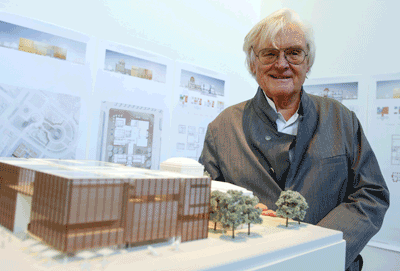

At 70-years-old, Von Gerkan, who oversaw
the construction of Tegel airport (finished in 1974), is well respected,
with works all over Germany. He called the associated construction work
“without any issues and undertaken in great harmony between all
stakeholders,” but then reportedly went on to say that “the
delays and cost overruns (associated with BER Airport) were mainly due
to a tsunami of change requests from the side of the former BER management
and board.”
Indeed, one issue that frequently came
up when the BER facilities failed to qualify for the acceptance test was
that the constructed facilities bore only some resemblance to the original
plans drawn up by von Gerkan because of the numerous change requests from
the stakeholders.
It seems that both the former BER management
and board approved of changes and implemented them without bothering to
communicate such changes to the local authorities, which were tasked to
approve—or reject—the work.
Indeed the non-compliance with fire protection
laws was reported in clear language from the Commissioner for the Dahme-Spreewald
county months ahead of the planned opening date.

“A main reason for this disaster
is the huckster mentality of the airport stakeholders,” said von
Gerken, adding “their intentions made the airport building a giant
sales mechanism with coffee shops and retail fashion, misshaping a functional
building to a mall with airport access.
“Why passengers should carry overpriced
whiskey around in a bag like bums escapes me—in Tegel, all I put
in were some paper stores, a souvenir shop and phone booths.
“That made for a convenient distance
of 20 meters from the taxi lane to the check in, all the comfort a frequent
flyer really wants,” von Gerkan said.
“There were several hundred change
requests which ultimately resulted in the drawings not having much resemblance
to what was actually built.
“In developing nations, such illegal
practice may be considered normal, but BER is on German, actually Prussian,
territory.
“The temptations of omnipotence on
the side of the airport stakeholders should be rejected,” von Gerkan
concluded.
He summarizes that “architecture
thereby is turned into a pool of failed realities, wishful thinking, and
utopia.”
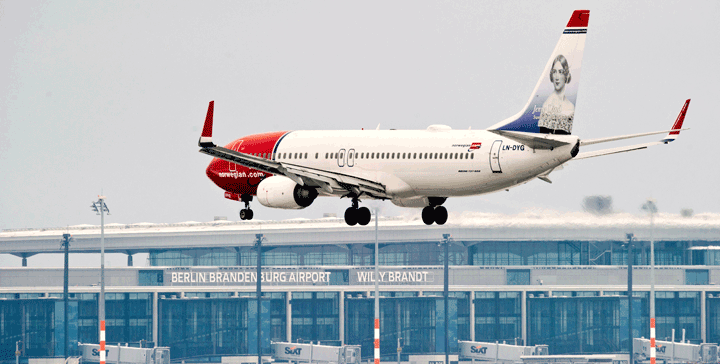 |

The main reason that BER cannot pass its
mandated acceptance test is the complexity of the fire protection system,
which covers numerous floors, 75,000 sprinklers, 16,000 smoke detectors,
3,400 flaps in air vent channels, and allows for a smoke-free zone within
15 minutes of activation.
For this to happen, 3.4 million cubic meters
of air must be moved through underground exhaust ducts, (a system never
tried beforehand) because the roof of the terminal building, for design
reasons, could not accomodate any exhausts or chimneys.
Since neither the computer equipment nor
the complex cabling is currently able to handle the specified tasks and
since plans and key personnel who were familiar with these issues have
vanished in the woes following the failed June 2012 opening, it is incredibly
difficult to track the exact specifications and come up with subsequent
corrective measures.
According to some German press reports
published in March of this year, the eventual outcome of Mr. Amman’s
assessment of the 20,000 different pending issues at the BER construction
facility may even necessitate tearing down the greater part of the terminal
building since a considerable part of the fire protection system was either
not built to specifications or had none to speak of.
The hands-on approach taken by the former
BER management to pass the fire protection acceptance test was to place
volunteers with radio communication equipment at the exhaust controls
and fire doors and open these manually, a procedure flatly rejected by
the fire protection authorities of the Dahme-Spreewald county.
Probably the former airport management
were the only ones surprised by such response; it seems unlikely that
any liability insurance provider would have signed off on such a thing.
Apparently both Mr. Koertgen and Mr. Schwarz
face liability-related civil lawsuits regarding the cost overruns and
other pending issues, for which they rely on the coverage provided by
their D & O insurance—whether such insurance needs to cover
gross incompetence remains to be seen.

The new CEO of BER, Hartmut Mehdorn has
repeatedly pledged a ‘little-by-little’ opening of the facilities,
although this approach has been clearly rejected by all members of the
supervisory board and the operators serving the Berlin airports.
Whether it is feasible to operate anything
on premises that have not yet proven the ability to pass the acceptance
test is at least debatable.

A much overlooked issue is that since the
former BER management was adamant about opening on June 3rd, 2012, many
passenger and cargo handling related companies as well as retailers had
terminated leases in the vicinity of Tegel or elsewhere, hired on new
staff, and dismissed staff who were not willing to commute to the new
BER.
The costs of these businesses have not
yet been established (since BER is still not open), but the BER airport
company will certainly face compensation lawsuits.
Ironically, in his previous role as Air
Berlin CEO, Hartmut Mehdorn was one of the first to demand €20 million
as an interim compensation for AB’s losses relating to the delayed
BER opening, since Tegel does not allow AB to incorporate a hub structure
with other Oneworld members as planned.

The new BER cargo center was actually completed
on schedule since this fell under the responsibility of a private investor,
Dietz AG.
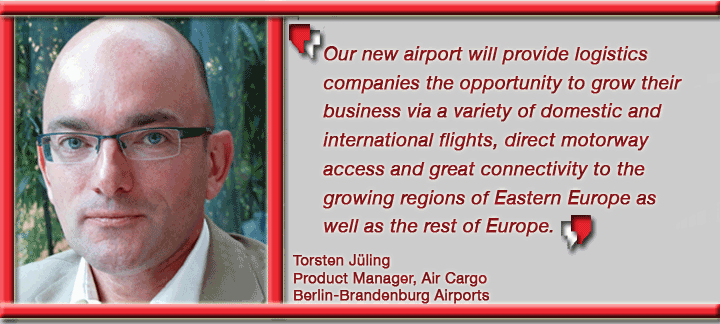 |
It could have been opened on time, had there
been any traffic at the new airport. Since all cargo is already handled
at Schoenefeld Airport, very few of the cargo center’s offices are
being currently used.
Torsten Jüling, Product Manager, Aircargo,
Berlin-Brandenburg Airports, is soft spoken and somewhat self-effacing;
the long and short of it is that he feels the opportunity for the soft
opening of the air cargo facility will pave the way for a solid cargo
operation in place when the airport opens.
“Our new airport will provide logistics
companies the opportunity to grow their business via a variety of domestic
and international flights, direct motorway access and great connectivity
to the growing regions of Eastern Europe as well as the rest of Europe."
Mehdorn proudly told German newspaper DVZ
that the new cargo center would be opened July 3rd and fully operational
“in early August,” by which time the entire cargo handling
on the north side of the existing Schoenefeld facilities will be terminated
to allow for much needed structural repairs.
In a letter from Mehdorn to the cargo companies
in question, he called this a “challenging task,” according
to DVZ; however, the majority of belly cargo is still handled
in Tegel and the integrator operations will remain in Schoenefeld. The
monthly volume handled in the new cargo center will likely not exceed
100 tons per month.
By comparison, Frankfurt Airport handled
100,000 tons in May 2013. After making the required repairs, the integrators
will actually have ample expansion space in the Schoenefeld-North facilities.
Also Mehdorn propagates opening the North
pier of the BER, dedicated to low-cost passenger operations, a.s.a.p.,
with “two or three small carriers and maybe less than a dozen flights.”
Mehdorn goes up against the strict objection
from the stakeholders towards these phased-in plans by saying that he
“just can’t see BER getting up to speed from standstill.”
He also recommends the existing Tegel facilities
remain open even after a BER full opening, pointing to the known capacity
issues in BER, the waste of existing facilities (which have already been
earmarked for university premises, technology development, research companies),
although knowing full well that Tegel’s operating permit will automatically
expire six months after the opening of BER, whenever this may be.
The latter, interestingly enough, must
be seen as a true achievement of German bureaucracy, since the previous
BER management filed for expiration of the Tegel permit 6 months after
the planned June 3rd, 2012, opening date; it was the hands-on approach
of the authorities in question who changed this into a flexible date set
six months after BER becoming operational.

One thing is certain: BER airport will
certainly have to expand and will provide good employment opportunities—within
their legal department.
Aside from the lawsuits related to compensation
payments from the side of operators, handlers, forwarders, and retailers,
and the yet undetermined liability issues, BER also faces harsh opposition
from citizens in the neighboring areas, the greater Berlin area, and the
European commission.
Just like in Frankfurt, noise is a big
issue in Germany.
On April 25th, 2013, the Higher Administrative
Court of Berlin ruled the noise protection program of BER to be insufficient.
The verdict called the BER airport noise
protection program “insufficient and contradicting regulatory requirements.”
This means that in the opinion of the court,
not enough compensation is paid by the airport for noise reduction measures,
such as alternating flight routes and paying for better noise insulation
for affected homeowners.
Airport noise may not exceed 55 db/a in
the 14,000 dwellings affected.
The original program implemented by BER
management budgeted €139 million but had already been increased to
€444 million in 2012 to cover that expense.
A further investment of €286 million
is needed to satisfy the minimum requirements of the court’s verdict,
for which an appeal was not permitted.
These additional costs have to date not
been included in BER’s planning costs.
Mehdorn told the German press that he believed
the court’s verdict to be the “premium on democracy”
also stating “we should be happy for having to pay such a price.”

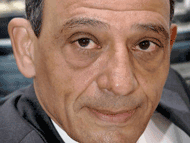 It should be mentioned that just this past April Mr. Mehdorn added an
engineer, Hany Azer, as part of a new working group program called "Sprint"
BER Airport that is supposed to “sprint” things along towards
getting the airport opened.
It should be mentioned that just this past April Mr. Mehdorn added an
engineer, Hany Azer, as part of a new working group program called "Sprint"
BER Airport that is supposed to “sprint” things along towards
getting the airport opened.
Mr. Azer was formerly Chief planning officer
for the highly controversial underground mega-rail station Stuttgart 21,
another project where costs have exploded.
Mr. Azer's former employer, Deutsche Bahn,
confirmed that employment of Mr. Azer necessitated providing a maximum
of personal security—something Mr. Amman never required.

As if this wasn’t enough, the European
Commission in Brussels has initiated formal proceedings against Germany
because of the alleged violation of binding European Community Directives
in regard to environmental laws when planning and constructing the BER
airport.
“As things are now, we would tell
Germany that parts of its national laws are not respecting EC environmental
requirements and thus we would expect Germany to change this in a way
compliant with EC requirements,” a speaker of the EC outlined on
May 29, 2013.
The EC notified Germany back in January
of this year that the flight paths to and from BER airport differed considerably
from those previously discussed and no mandatory EC environmental assessment
existed for those actually implemented.
The routing through natural preserves and
bird preserves would thus be considered in violation of applicable EC
laws.
The EC may challenge Germany’s non-adherence
to EC standards in the Luxembourg EC court and/or impose monetary penalties
until all EC requirements are complied with.
In the meantime, the BER Airport construction
facility continues to cost well in excess of 20 million Euros a month
for maintenance, electrical power, and security.
Costs for electrical power already exceed
those of the operating airport Tegel while the Airports new CEO, Hartmut
Mehdorn, continues to make the headlines.
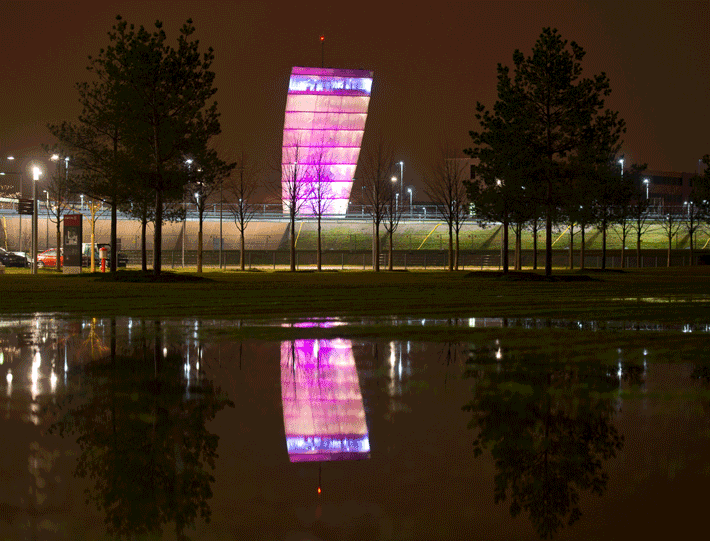 Towering
reflections at Berlin Brandenburg as some wonder if the airport
will be able to fully open by 2014. Towering
reflections at Berlin Brandenburg as some wonder if the airport
will be able to fully open by 2014.
|

There is this wonderful comic bank robbery
gone wrong, a fictional novel based on true facts, written decades ago
by Jimmy Breslin and titled "The Gang That Couldn’t Shoot
Straight".
Writing this story reminds us that while
building an airport is by no means a walk in the Tiergarten, these people
who set about creating BER have managed to screw things up better than
anything else they did.
“Much turmoil but no action”
headlined German Manager Magazine on June 17, 2013, when commenting
on a press conference at which BER management was to explain how—and
if—BER airport construction was to continue.
Mehdorn himself was absent at that presser,
because of alleged “stomach issues.”
Manager Magazine jumped on that
issue, quipping:
“Usually stomach issues are encountered
by those who had to deal with Mr. Mehdorn.”
So as July 2013 begins, hundreds of thousands
who are tired of all this upheaval in the press and everywhere else are
wondering: where is the airport?
(Stay tuned)
Jens/Geoffrey/Flossie
|





 This
time, however, even the German public, which has a notoriously short-lived
memory for political issues, did not believe the statements.
This
time, however, even the German public, which has a notoriously short-lived
memory for political issues, did not believe the statements.  As
FT reported earlier, attempts failed to bring in Wilhelm Bender,
(left) former successful CEO of Frankfurt Airport, as a replacement for
Schwarz after Berlin Mayor Wowereit and State of Brandenburg PM Platzeck
broke confidentiality in negotiations. However, today Herr Bender continues
to serve as a consultant to the project.
As
FT reported earlier, attempts failed to bring in Wilhelm Bender,
(left) former successful CEO of Frankfurt Airport, as a replacement for
Schwarz after Berlin Mayor Wowereit and State of Brandenburg PM Platzeck
broke confidentiality in negotiations. However, today Herr Bender continues
to serve as a consultant to the project.  In
a related development, the Vice President, State of Brandenburg PM Platzeck
replaced the President of the BER Supervisory Board, Mayor Wowereit, under
allegations that Wowereit had misinformed the public about the construction-related
problems.
In
a related development, the Vice President, State of Brandenburg PM Platzeck
replaced the President of the BER Supervisory Board, Mayor Wowereit, under
allegations that Wowereit had misinformed the public about the construction-related
problems.
 Obviously, the answers he had to give the supervisory board weren’t
much to their liking and seemingly contradicted the statements of the
now new CEO of BER, Hartmut Mehdorn, former CEO of cash-strapped Air Berlin
and notorious “sanitizer” of German rail monopolist Deutsche
Bahn.
Obviously, the answers he had to give the supervisory board weren’t
much to their liking and seemingly contradicted the statements of the
now new CEO of BER, Hartmut Mehdorn, former CEO of cash-strapped Air Berlin
and notorious “sanitizer” of German rail monopolist Deutsche
Bahn.




 It should be mentioned that just this past April Mr. Mehdorn added an
engineer, Hany Azer, as part of a new working group program called "Sprint"
BER Airport that is supposed to “sprint” things along towards
getting the airport opened.
It should be mentioned that just this past April Mr. Mehdorn added an
engineer, Hany Azer, as part of a new working group program called "Sprint"
BER Airport that is supposed to “sprint” things along towards
getting the airport opened.